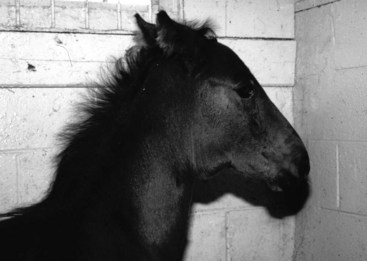Strangles
Basic Information 
Epidemiology
Contagion and Zoonosis
• Contagious: Spread by direct (horse-to-horse) or indirect (contaminated feed, water, equipment, or handlers) contact
 Nasal secretions of outwardly healthy horses, including horses incubating disease or recovering or subclinical carriers (carrier state develops in up to 10% of affected animals; the guttural pouch is the most common site of prolonged carriage)
Nasal secretions of outwardly healthy horses, including horses incubating disease or recovering or subclinical carriers (carrier state develops in up to 10% of affected animals; the guttural pouch is the most common site of prolonged carriage)Clinical Presentation
History, Chief Complaint
Acute swelling in the submandibular or retropharyngeal area, anorexia, nasal discharge
Physical Exam Findings
• Nasal discharge: May be initially serous, then mucopurulent
• Lymphadenopathy: Primarily submandibular and retropharyngeal lymph nodes, abscess formation (Figure 1)
• Hyperemic nasal and ocular mucosa
• Other signs depend on specific tissue involvement (eg, chronic weight loss often associated with internal abscessation or abnormal lung sounds associated with pneumonia, colic, neurologic signs, panophthalmitis, other)
Etiology and Pathophysiology
• S. equi subsp. equi: Gram-positive β-hemolytic coccoid bacterium; several virulence factors, including the surface protein SeM, which is antiphagocytic and immunogenic
• Enters via the mouth or nose and attaches to cells in the tonsils; the organism is translocated to the lymph nodes within a few hours.
• Infection results in the production of inflammatory mediators, which attract large numbers of neutrophils, leading to abscess formation.
• First sign of infection is fever, which generally occurs 3 to 14 days after exposure.
• Nasal shedding typically begins 2 to 3 days after onset of fever and generally lasts 2 to 6 weeks after the cessation of clinical signs.
• Disease severity depends on challenge load and duration as well as host factors.
• The majority of exposed horses develop immunity, which lasts for 5 or more years.
Diagnosis 
Initial Database
• Complete blood count and fibrinogen: Most often neutrophilic leukocytosis and hyperfibrinogenemia; may see anemia or thrombocytosis, especially in chronic cases
• Serum chemistry: May see hyperglobulinemia; other abnormalities may reflect specific organ involvement such as the liver
• Endoscopic examination: Collapse of the nasopharynx, guttural pouch empyema, and chondroids
• Ultrasonography: May be used to confirm abscessation and identify areas of fluid; useful in evaluation of the thorax and abdomen
• Radiographs: Soft tissue density in the retropharyngeal area, fluid in the guttural pouch, thickening in the roof of the pharynx, distortion of the pharyngeal airway or trachea







